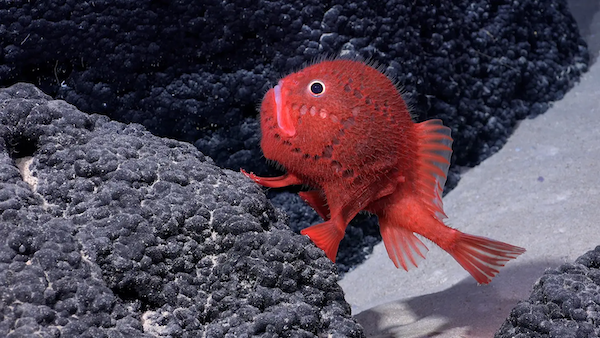

(quote)
“If You Can’t Beat Them, Eat Them”
A new kind of out-of-town visitor likes to check out the famous Brandenburg Tor in Berlin these days: Louisiana crawfish scuttles through the site when it rains. After business consultants Lukas and Juliane Bosch learned three years ago that they had become invasive in Berlin, the couple had an aha-moment. “We read that the invasive species has no natural enemies in the ecosystem,” Lukas says, which is why they’d come to run rampant. “That logic only works if you omit humans from the food chain.”
Why not simply eat the invaders? After all, the crawfish is a delicacy in Louisiana because it tastes almost like lobster. Together with Berlin gourmet chef Andreas Michelus, the couple started buying the crawfish from a licensed fisherman, developed recipes and bought a food truck. Their company, Holycrab!, was born. “Why fly exotic ingredients around the world when they live outside your front door?” the founders ask. “If you can’t beat them, eat them.”
The main challenge was getting Germans interested in trying new foods, “so we put it in dishes people were already familiar with, such as crab rolls or ‘pasta di plague,’” Juliane says. When the crawfish season ended in the fall, they switched to wild boar and Nile goose, which are also invasive.
The couple is now living with their child in Offenbach near Frankfurt, and because farmers complained that the geese are eating ingredients such as watercress and sorrel for the popular German “green sauce,” the Holycrabbers deliberately added a recipe for Nile goose with green sauce “as a conversation starter.” Later they added other invaders to the menu: carp sandwiches, bouillabaisse with Chinese crab, raccoon steak, and a stew made from the raccoon-sized rodent nutria, plus invasive plants and roots as salads and fries. It’s illegal in Germany (and most parts of Europe) to simply shoot or fish your own lunch. You need a permit, and to make sure no illnesses get transmitted, every piece of wild meat needs to be tested and certified before consumption. “Once a young, inexperienced hunter simply showed up at our front door with a 100-pound boar,” the couple recalls, laughing. “We had to send him away and explain he needed to get the meat tested first.”
The eat-the-invaders movement actually started in the United States. Renowned conservation biologist Joe Roman from the University of Vermont kickstarted the “invasivorism” trend in 2011 after he completed his PhD on the damage invasive European green crabs inflict in the US. Websites such as Roman’s are dedicated to identifying edible aliens and publishing recipes for snails, snakes, iguanas, nutrias, and other invasive species. Many of them either hitched rides as blind passengers on a boat or were brought in deliberately only to have their numbers spiral out of control because they have no natural enemies in their new environment.
The damage invasive species are causing is immense: Experts estimate that the aliens are responsible for nearly a third of extinctions worldwide and have cost farmers and communities more than $1.3 trillion in damages. Out of the 50,000 nonnative species in the US, 4,300 have been labeled invasive. To name a few of the worst offenders, nutrias destroy Louisiana marshes; European green crabs devoured a billion dollars worth of mussels and clams in US waters; sea lampreys usurp trout in the Great Lakes; Burmese pythons strangle native deer in the Florida Everglades, and feral pigs, considered “super invaders,” are ripping up lawns, golf courses and vineyards in the Bay Area, even threatening the area’s drinking water supply. According to the Department of Agriculture, more than six million feral pigs live in the US, hybrid offspring of domesticated pigs and wild boar that was imported around the 1900s for sport hunting. California is currently debating a bill to make hunting them easier so more of them can be made into pork chops and sausages.
Once an invasive species like crawfish has been introduced to a new region, it is nearly impossible to get rid of it entirely. But especially in countries with a high rate of malnutrition, such as Madagascar, scientists and activists have educated the population about the benefits of eating the protein-rich invaders with some success.
Can We Really Eat Invasive Species into Submission? The tale of a giant Amazon fish reveals the promise and peril of “invasivorism”
Las Peñitas, Bolivia—Before he had ever seen a paiche, fish trader Eric Salazar had heard the giant Amazon fish could grow up to 10 feet long, weigh 400 pounds and eat a man whole. The paiche, or Arapaima gigas, is the world’s largest scaled freshwater fish. Native to the jungles of Peru and Brazil, it first appeared in nets in Bolivia’s Amazon Basin in the early 1990s. As it migrated upriver, rumors traveled with it. People said it was created by nefarious Peruvian scientists, that they fed it with the blood of farm animals, that it wasn’t a fish at all but a monster.
They weren’t entirely wrong. The paiche is carnivorous—although it eats other fishes, not humans. And it did enter Bolivia from Peru, where it had been added to the Convention on International Trade in Endangered Species index in 1975 as a species prone to extinction if trade was not closely controlled. A few years later a flood washed juveniles out of a Peruvian fish farm near the border into Bolivia’s watershed. By the time Bolivian fishermen noticed the strange creature, it was already established in the oxbow lakes and seasonal lagoons that dot the forest.
Since then, the paiche has spread across more than 45,000 square miles, roughly a quarter of the Bolivian Amazon. There are no official data yet on its impact, but there’s plenty of anecdotal evidence of environmental damage. Fishermen who have worked these waters for years say the native species they prefer to eat—particularly giant Amazon catfish such as surubí, bagre and pintado—have become scarce. Others, they say, have disappeared entirely.
In the past decade paiche meat has also become more popular among city dwellers. Conservation-minded chefs in the cities promote paiche as a sustainable choice, which is true at face value: The fish is a nuisance, and other edible river fishes are disappearing. The idea is to control or maybe even eradicate the fish by deliberately overfishing it, but Salazar, who profits handsomely from the paiche’s lean, white meat, says that would be impossible. “To eradicate the paiche,” he says, “would be to pull a star from the sky.”
Invasive species have followed us around the globe for as long as we have been mobile. They’ve hitched on the hulls of transoceanic ships, and we’ve carried them home with us deliberately, introducing them for food, farming and recreation. Invaders are now the second-most important cause of global biodiversity loss after habitat destruction, and the more we move about, the more they spread. Conservative estimates have invasives costing the U.S. tens of billions of dollars annually.
From lionfish crudo to pickled kudzu, these invasive species—usually destructive and disdained—can also be delicious.
The two dozen chefs in this open boat are here at the invitation of local scientists who need their help saving Louisiana’s threatened wetlands. The “swamp rat” in question is the invasive nutria, which is chewing up so much land the state has placed a six-dollar-a-tail bounty on the rodent.
Nutria hasn’t yet succeeded as a restaurant dish, but it turns out there’s a world of environmentally destructive, non-native plants and animals—from kudzu to feral hogs—that are increasingly gracing southern tables. The United States is home to more than 6,500 invasive species that can reproduce aggressively, out-compete and spread disease to local species, and destroy habitat, in addition to tens of thousands of non-native and “nuisance” species. Many of them, in the right chef’s hands, are quite tasty.
The South is hard-hit but hardly alone. There are annual “invasivore” cook-offs in Oregon, and invasive-crayfish boils around the Great Lakes. New England foodies recently teamed up with ecologists to create the Green Crab Cookbook, using recipes from Venice and Vietnam to entice people to dine “from problem to plate.” They even pivoted to a free program to distribute the invasive crab to stuck-at-home cooks, called Shuck at Home 2020.
(unquote)
Image courtesy FoodFrames and Nino Halm






